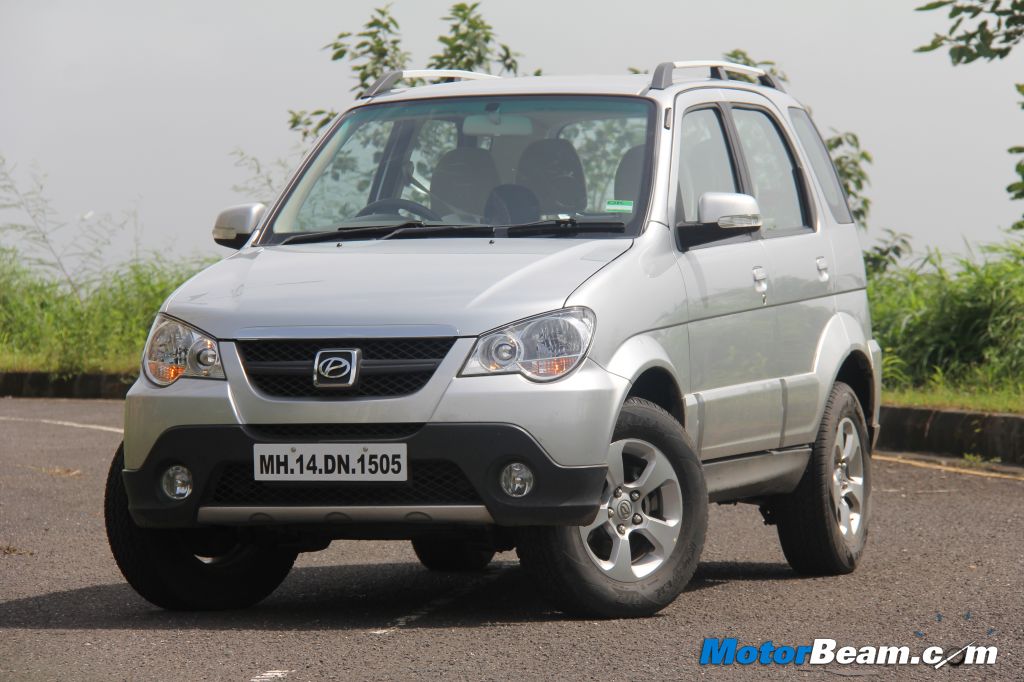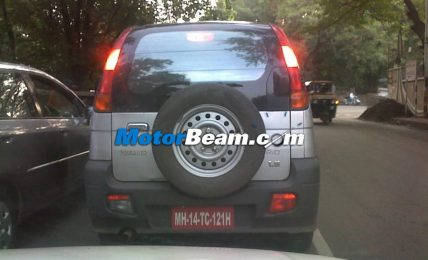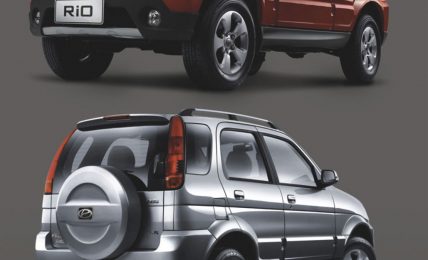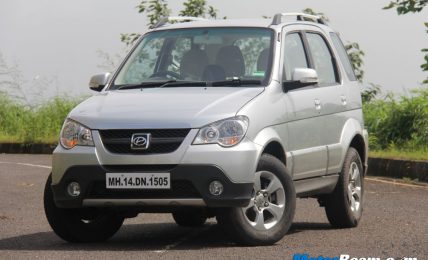
Premier RiO Review
Car tested: 2012 Premier Rio CRDi4
Price OTR Mumbai: Rs. 7,93,734/-
Premier is one of the oldest automobile manufacturers in India, dating all the way back to 1944. The company has never designed a vehicle ground up on its own and has tied up with numerous car makers to supply vehicles to them. The latest is the Rio (Zotye Nomad), which was launched in the Indian market a couple of years back. The Premier RiO is assembled in India (via the CKD route), with kits coming from China. Zotye brought the rights to produce the Terios from Daihatsu, a vehicle which was born almost 15 years ago! Now armed with Fiat’s Multijet diesel engine, the Premier RiO is aiming for BSIV markets, but does it have enough in it to lure the urban crowd? Let’s find out.
[flickr size=”center” float=”medium”]http://www.flickr.com/photos/motorbeam/7975924361/[/flickr]
Exteriors – The Premier RiO was given a mild facelift earlier this year. The car now features mildly updated styling but not much has changed. The RiO is a compact SUV and thus it measures less than 4-meters in length. The chunky cladding, big wheels, roof rails and tail gate mounted spare tyre gives it an impressive appearance. However the vehicle is too narrow, due to which it lacks the stance one would expect from an SUV. The reason why the Premier RiO is so narrow is because it was designed to comply with the Japanese Kei car requirement. A Kei car has to be less than 1500 mm in width. The advantage Kei cars get include lower taxes, lenient insurance regulations and exemption from parking certification. One of the most popular Kei cars in Japan is the Suzuki Wagon R.
[flickr size=”center” float=”medium”]http://www.flickr.com/photos/motorbeam/7975924181/[/flickr]
Premier doesn’t seem to have adapted the RiO for Indian markets. The antenna is placed on the left side, which is usually the norm for left hand drive markets.
[flickr size=”center” float=”medium”]http://www.flickr.com/photos/motorbeam/7975923416/[/flickr]
Interiors – Step inside and you are greeted with a two-tone arrangement of grey and beige. The doors open wide and you walk into the cabin (not crawl into it). Minor changes have been made to the interiors of the Premier RiO but the dashboard is very dated. Quality levels also need vast improvement for a vehicle of this price. Plastic quality is just about average while there are quite a few panel gaps. There is inconsistency in the materials used, like the boot open button is made of plastic, the fuel gauge button is made of steel.
[flickr size=”center” float=”medium”]http://www.flickr.com/photos/motorbeam/7975922726/[/flickr]
The instrument cluster is easy to read but looks very dated. The driver’s seat offers a very good view of the road ahead and that is one of the biggest advantage of the Premier RiO. However due to the narrowness of the car, you don’t have enough space and the RiO is best for four passengers. Sitting in the driver’s seat, your right leg will hit the right door, while your left one will hit the centre console (which has silver finishing). Even with the seats pushed all the way back, the steering wheel would scrub my leg on turning it. There is no dead pedal either.
[flickr size=”center” float=”medium”]http://www.flickr.com/photos/motorbeam/7975924068/[/flickr]
[flickr size=”center” float=”medium”]http://www.flickr.com/photos/motorbeam/7975922953/[/flickr]
There is ample amount of head room in the car but legroom and kneeroom is not enough for tall passengers (neither at the front, nor at the rear). The power window switches have been placed very inconveniently (horizontally, instead of vertically) and there are no power windows for the rear passengers. The door lock and unlock button is not easy to reach and you have to turn all the way around to access them (on the door). The head light leveler switch is placed below the steering wheel on the left side which is not easy to use. The air-conditioner works well but gets too noisy on high fan speed. The rotary knobs of the air-con are too hard to use as well. The only modern bit to the interiors is the audio system, which is a 2-din unit featuring AUX and USB ports.
[flickr size=”center” float=”medium”]http://www.flickr.com/photos/motorbeam/7975923848/[/flickr]
Boot space is a good 454-litres and the middle row of seats fold forward to increase luggage space to 1158-litres.
[flickr size=”center” float=”medium”]http://www.flickr.com/photos/motorbeam/7975921775/[/flickr]
Ride, Handling and Braking – The Multijet powered Premier RiO weighs the same as the TUD5 equipped RiO. Premier has tweaked the suspension and has made it softer, which gives the RiO very good ride at low speeds. But as speeds increase, the RiO tends to be thrown around quite a bit on bad roads. The RiO does have a very good turning radius of just 4.7-meters, making it very easy to maneuver the car in the city. However out on the highway, the car lacks high speed stability and tends to be ruffled easily by cross winds.
[flickr size=”center” float=”medium”]http://www.flickr.com/photos/motorbeam/7975927472/[/flickr]
Even though the Premier RiO doesn’t weigh much, its handling is just about average. The tall height and massive ground clearance gives it a lot of body roll and the steering is not at all precise and lacks any sort of feedback. The Premier RiO is certainly not a car you would push around corners. Braking is aided by ABS but the feel of the brakes is not good. You have to dial in massive corrections from the steering wheel to ensure the RiO stops in line.
[flickr size=”center” float=”medium”]http://www.flickr.com/photos/motorbeam/7975926147/[/flickr]
Performance – The Premier RiO now gets Fiat’s Multijet magic, the 1.3-litre diesel engine which produces 72 BHP of power and 183 Nm of torque. The engine cover reads ‘Multijet’ and is the very same one found on Fiat cars. There was some difficultly in mounting this engine into the car as this is the very first time the Multijet engine has been mounted longitudinally (it has always been mounted transversely). It is also the very first time the 1.3-litre Multijet engine transfers power to the rear wheels (instead of the front). Due to this, the engine is paired to the 5-speed Mitsubishi gearbox found on the Peugeot TUD5 engined RiO. This gearbox feels a bit clunky and shift action is far from positive. The clutch also feels a bit heavy and the Multijet motor is quite noisy in the RiO. NVH levels are a big leap from the TUD5 model but the worst in a Multijet powered car yet.
[flickr size=”center” float=”medium”]http://www.flickr.com/photos/motorbeam/7975925752/[/flickr]
With the Fiat magic working under the hood, the Premier Rio CRDI4 feels decently quick and doesn’t start to run out of breath till 110 km/h. The driveability of this motor is very good and once the turbo kicks in around 2000 RPM, the RiO makes very good progress. The RiO redlines all the way at 5000 RPM and its mid-range is quite strong (till 3500 RPM). The engine does get quite noisy at around 4000 RPM but if you keep the car in its powerband, it does perform very well. Overall the performance is extremely positive and is a huge leap over the TUD5 diesel engine. The Multijet equipped RiO also returns a very good mileage of around 15.5 km/l in mixed driving conditions.
[flickr size=”center” float=”medium”]http://www.flickr.com/photos/motorbeam/7975927114/[/flickr]
Conclusion – The Premier Rio with Fiat’s Multijet diesel engine is undoubtedly the best RiO yet. However there are quite a few drawbacks, which simply can’t be ignored. At a price of almost Rs. 8 lakhs (on-road, Mumbai), the RiO is not the best in terms of quality and driving dynamics compared to similarly priced hatchbacks. The Multijet diesel engine does improve performance drastically and as the cheapest compact SUV in India today, there is no option which comes close to the RiO in terms of pricing. But, we would still recommend people to put in more money or opt for another body style of car then to buy the Premier RiO which is not only very dated a vehicle but also completely out of place in today’s modern times.
[flickr size=”center” float=”medium”]http://www.flickr.com/photos/motorbeam/7975924527/[/flickr]
Whats Cool
* Multijet Diesel Engine
* Ground Clearance
Whats Not So Cool
* Plastics and panel gaps
* Driving Dynamics
* Space and Ergonomics
[flickr size=”center” float=”medium”]http://www.flickr.com/photos/motorbeam/7975926082/[/flickr]
Premier Rio Specifications
* Engine: 1248 cc, 16V, Multijet, DOHC
* Power: 72 BHP @ 4000 RPM
* Torque: 183 Nm @ 1800-2400 RPM
* Transmission: 5-speed manual
* Top Speed: 140 km/h
* 0-100 km/h: 19.50 seconds
* Fuel Consumption: 13-14 km/l (City), 17-18 km/l (highway)
* Fuel Type: Diesel
* Suspension: McPherson strut and coil spring (Front), 5 rods system (Rear)
* Tires: 205/70/15 Tubeless Radials
* Brakes: Disc (Front) Drums (Rear), ABS
* Safety: ABS
Premier Rio Dimensions
* Overall length x width x height: 3970 mm X 1570 mm X 1730 mm
* Wheelbase: 2420 mm
* Front/Rear Track: 1305/1310 mm
* Ground clearance: 200 mm
* Turning Radius: 4.7-meters
* Boot Volume: 454-litres, 1158-litres (with rear seats folded)
* Fuel Tank Capacity: 46-litres
* Kerb Weight: 1145 kgs




